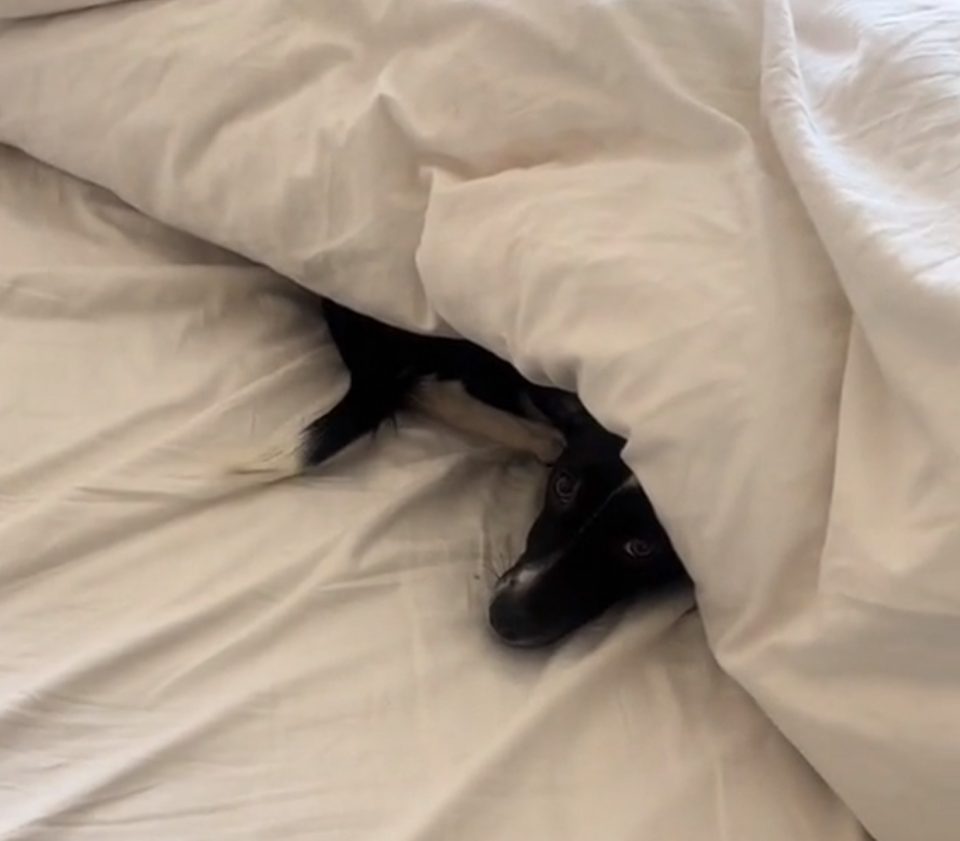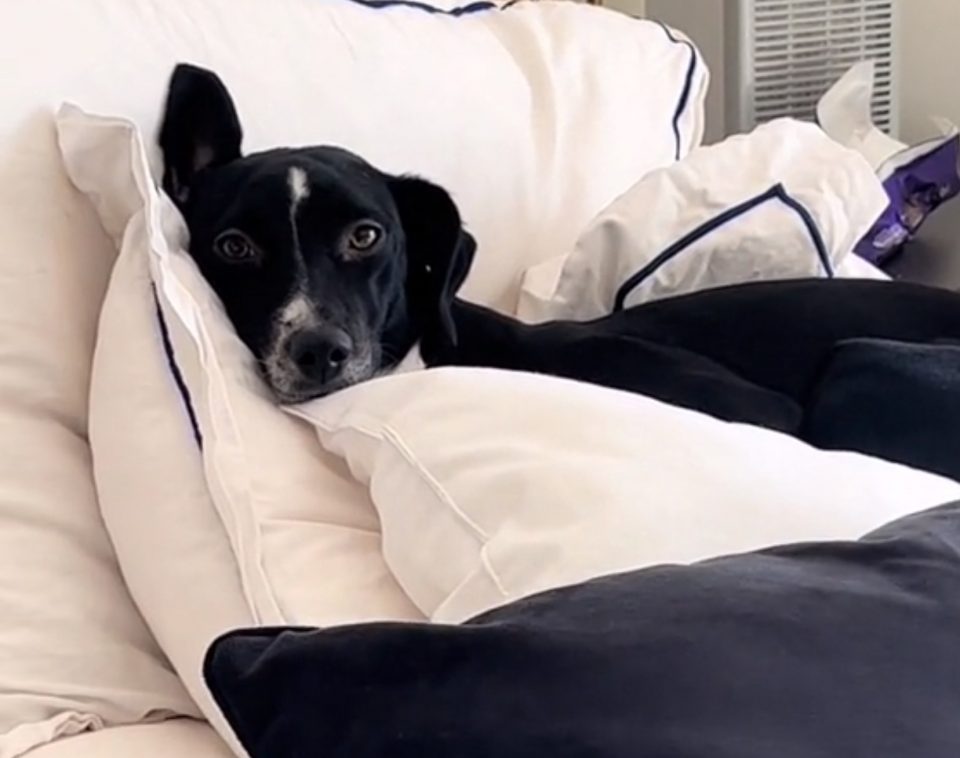Many believe that by making your bed first thing in the morning, you are setting yourself up for a very successful day.
A woman by the name of Sophie Gallagher made it her routine to make her bed as soon as she woke up, thinking she would have it nice and tidy throughout the entirety of the day.
However, she started noticing that it would suddenly become unmade during the day – the cover would be all messed up, and the pillows would be all over the place.
But, it didn’t take her too long to realize what was truly going on.
The Cutest Culprit

Posting a video on TikTok, Gallagher revealed that it was actually her 18-month-old dog, Dot, who was doing this. In the video, Dot can be seen hiding underneath the covers, being all cute and cuddly.
Gallagher could spend all the time in the world trying to make her bed look all clean and pristine, but that didn’t matter to Dot. As soon as she saw the opportunity, she would make her way to the bed and treat herself to a little nap.
In an interview with Newsweek, Gallagher revealed that she was blaming her boyfriend for messing the bed the entire time only to realize that “the Queen was undoing it to tuck herself in.”

Even though Dot slept in the bed ever since she was rescued in 2022, she decided that it simply wasn’t enough.
This sleepy pup would get in the bed whenever she wanted and would stay there for as long as she preferred.
Thinking this was the most adorable thing ever, Gallagher couldn’t help but share it on her TikTok, showing the whole world the cutest little rebel.
Everybody loved it so much that they made Dot TikTok famous in a matter of days!
“I work from home on a Monday, Thursday, and Friday, so, after she’s come running with me in the morning, she will bring herself back to bed and tuck herself under the covers. She spends as much time as she likes in the bed, and we have accepted the fact that it’s now her bed, too. I can’t get angry at her because it’s just too funny. We are so lucky to have such a humorous dog,” she told Newsweek.
Even though many believe that this is just regular dog behaviour, the American Kennel Club (AKC) stated that there were a couple of different reasons for it.
On the other hand, however, it can also be the fact that some dogs love the companionship and warmth that beds tend to provide.

Happy Dog, Happy Owner
Gallagher stated that adopting Dot was one of the most rewarding feelings ever and she now encourages everyone to do the same if they can.
“There is such satisfaction in giving a dog who has neglected the best possible life, with endless cuddles, lie-ins, walks, and treats galore,” she said.
Knowing that she didn’t have a happy life before, allowing her to sleep whenever she wanted is the least she could do for her, and everybody in the video’s comments couldn’t agree more.
“I didn’t think the video would get any attention. It was just for my own documentation of all our funny memories with Dot, but the response has been hilarious,” said Gallagher.

Gallagher can make her bed as many times as she wants, but I know that seeing Dot’s adorable face underneath those covers is something truly priceless.
If you’ve ever wondered how your furry companion ends up with those pesky worms, you’re not alone. As a seasoned dog enthusiast, you know that these unwelcome guests can sneak their way into your pup’s system without warning. Understanding the various ways dogs can pick up worms is essential for keeping your four-legged friend healthy and happy. From innocent sniffing sessions at the park to unsuspecting interactions with contaminated soil, there are several common avenues through which dogs can acquire these unwelcome visitors.
Imagine your dog’s daily adventures, from playful romps in the backyard to curious explorations on walks. It’s during these moments that they unknowingly expose themselves to potential worm sources. As a responsible pet owner, being aware of how these parasites can find their way into your dog’s system is key to safeguarding their well-being. Stay tuned as we unravel the mystery behind how dogs contract worms and what you can do to protect your canine companion.
Understanding Worms in Dogs
When it comes to understanding worms in dogs, it’s crucial to grasp how these pesky parasites can sneak into your pup’s system. Here are the key points to keep in mind:
1. Types of Worms:
- Dogs can get infected with various types of worms, including roundworms, hookworms, tapeworms, and whipworms.
- Each type of worm has its own distinct lifecycle and methods of transmission.
2. Transmission Routes:
- Worms can enter your dog’s system through various means, such as ingesting contaminated soil, grooming infected feces, or through flea and mosquito bites.
- Puppies can also get worms from their mothers during pregnancy or nursing.
3. Symptoms of Worm Infestation:
- Watch out for common signs of a worm infestation in dogs, like diarrhea, vomiting, weight loss, bloated belly, and scooting.
- Some worms, like tapeworms, may cause visible segments in your dog’s feces or around their hind end.
4. Diagnostic Procedures:
- If you suspect your dog has worms, consult your vet for proper diagnosis.
- Vets can conduct fecal tests to identify the specific type of worm infesting your dog and recommend appropriate treatment.
- Protect your furry friend from worms by keeping their living areas clean, practicing good hygiene, and administering regular deworming medications as prescribed by your vet.
- Treatments for worms may vary based on the type of parasite, so always follow your vet’s recommendations.
Understanding how worms can affect your dog is crucial for maintaining their health and well-being. Stay vigilant, keep your pup protected, and consult your vet for the best care possible.
Common Types of Worms in Dogs
When it comes to worms that can affect dogs, there are several common types to be aware of. Here are the key varieties:
- Roundworms: These are one of the most prevalent intestinal parasites in dogs. They can be transmitted through infected feces or nursing from an infected mother dog.
- Hookworms: These worms are small and hook-like, attaching to the walls of the dog’s intestines and feeding on blood. Dogs can contract hookworms through ingestion, skin contact, or even prenatal transmission.
- Tapeworms: Tapeworms are segmented parasites that can grow quite long inside a dog’s intestines. Dogs may get tapeworms by ingesting infected fleas, lice, or rodents.
- Whipworms: Whipworms are another type of intestinal parasite that can cause health issues in dogs. Dogs usually pick up whipworm eggs from contaminated environments.
Being aware of these common types of worms in dogs is essential for recognizing symptoms and getting the right treatment promptly. Regular vet check-ups can help detect and address worm infestations early on, ensuring your furry friend stays healthy and happy.
Transmission of Worms to Dogs
Understanding how worms are transmitted to dogs is crucial in preventing infestations and keeping your furry friend healthy. Here’s how these pesky parasites can find their way into your pup’s system:
- Direct Ingestion: Dogs can pick up certain types of worms like roundworms and tapeworms by ingesting infected feces, either from other animals or contaminated soil.
- Eating Infected Prey: If your dog enjoys hunting or scavenging, they may consume prey animals like rodents or birds that harbor worm larvae, leading to an infestation.
- Mosquito Bites: Heartworm disease, caused by parasitic worms transmitted through mosquito bites, can affect dogs when infected mosquitoes bite them.
- Mother to Pup: Puppies can acquire certain worms from their mothers either during gestation or through nursing, highlighting the importance of deworming protocols for pregnant dogs.
- Transmitted by Vectors: Some worms, like hookworms, can penetrate a dog’s skin, especially through areas with warm and moist climates, emphasizing the need for preventative measures.
- Environmental Exposure: Dogs can contract certain worms like whipworms by coming into contact with contaminated soil where infected dogs have defecated.
By being aware of these transmission methods, you can take proactive steps to protect your dog from worm infestations and ensure their well-being. Regular vet check-ups and preventive measures are key in maintaining your dog’s health. Stay vigilant and provide a safe environment for your canine companion to thrive.
Symptoms of Worm Infestation in Dogs
When it comes to worms in dogs, being able to recognize the symptoms of worm infestation is crucial for your furry companion’s health. Here are common signs that your dog may have worms:
- Unexplained Weight Loss: If your dog is losing weight despite eating normally, it could be a sign of a worm infestation.
- Visible Worms in Feces or Vomit: Seeing worms in your dog’s feces or vomit is a clear indicator of a worm infestation.
- Diarrhea: Persistent diarrhea, especially if it’s accompanied by blood or mucus, can be a symptom of worms.
- Bloated Belly: A swollen or bloated belly, particularly if it’s sudden, could suggest a worm infestation.
- Lethargy: If your dog is unusually tired, lacks energy, or seems lethargic, worms could be the cause.
- Vomiting: Frequent vomiting, particularly if it contains worms, is a concerning symptom.
- Scratching or Dragging Bottom: Excessive itching, scooting, or dragging their bottom along the ground may indicate worms.
- Poor Coat Condition: A dull, rough, or dry coat could be a sign of underlying health issues, including worms.
By being aware of these symptoms, you can promptly seek veterinary care and ensure your dog receives the necessary treatment to combat worm infestations effectively. Regular check-ups and preventive measures are key to keeping your canine companion healthy and happy.
Preventing Worm Infections in Dogs
When it comes to keeping your furry friend healthy and happy, preventing worm infections plays a crucial role. Here are some practical steps you can take to safeguard your dog’s well-being:
Regular Veterinarian Check-Ups
Regular check-ups with your vet are essential for monitoring your dog’s overall health, including any signs of worm infestations. Your vet can recommend a suitable deworming schedule based on your dog’s lifestyle and potential exposure to worms.
Maintain Clean Living Spaces
Maintaining a clean environment for your dog is key to preventing worm infections. Regularly clean up your dog’s stool in your yard and avoid areas where other animals may have defecated. This helps reduce the risk of exposure to worm larvae.
Prevent Fleas and Ticks
Fleas and ticks can transmit worms to your dog, so it’s crucial to use preventive measures to keep these parasites at bay. Consult your vet for safe and effective flea and tick prevention methods.
Practice Good Hygiene
Practice good hygiene not only for your dog but also for yourself. Wash your hands after handling your dog, especially after cleaning up feces, to minimize the risk of worm transmission.
Avoid Feeding Raw Meat
Raw meat, particularly undercooked or contaminated with parasites, can pose a risk of worm infections. Ensure your dog’s diet is balanced and free from raw meat to prevent potential worm infestations.
Be Mindful of Interactions
Monitor your dog’s interactions with other animals, especially those with unknown health histories. Avoid letting your dog socialize with animals that may carry worms.
By following these preventive measures and staying vigilant about your dog’s health, you can help protect them from the risks of worm infections and ensure they lead a happy and healthy life.
Conclusion
That’s a wrap on how dogs can pick up those pesky worms. Remember, staying on top of your pup’s health is key. Keep an eye out for any unusual signs and make those vet visits a regular thing. A clean environment and some good old hygiene can go a long way in keeping those worms at bay. And hey, no raw meat for your furry friend! By taking these simple steps, you’ll be giving your doggo the best shot at a worm-free life. Cheers to happy, healthy pups!
Frequently Asked Questions
What are the common types of worms that can affect dogs?
There are several common types of worms that can affect dogs, including roundworms, tapeworms, hookworms, and whipworms.
What are the symptoms of worms in dogs?
Symptoms of worms in dogs may include weight loss, visible worms in feces or vomit, diarrhea, vomiting, bloated belly, scooting on the ground, and lethargy.
How are worms in dogs diagnosed?
Worms in dogs are typically diagnosed through a fecal examination performed by a veterinarian to identify eggs or adult worms.
What is the treatment for worms in dogs?
The treatment for worms in dogs usually involves deworming medications prescribed by a veterinarian based on the type of worm infestation.
How can I prevent my dog from getting worms?
To prevent worms in dogs, it is essential to maintain regular vet check-ups, keep living spaces clean, prevent fleas and ticks, practice good hygiene, avoid raw meat, and monitor interactions with other animals.
[no_toc]

Hey there, I’m Janet Brooks, a dog-loving student from California. I’m all about helping pups in need, especially those without homes. Me and my awesome friends work together to give shelter and love to stray dogs. Oh, and I also write blogs about dogs to share helpful info.